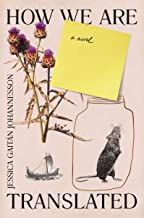
Kristen is a Swedish young woman living in Edinburgh with a Scottish man of Brazilian heritage. She works in the Castle Museum, the National Museum of Immigration, that celebrates the history of Scotland by providing a living exhibition of all the peoples who have contributed to Scottish history. She is part of the Nordic peoples exhibition, a Norse woman who came with the raiders to find a new place to farm. Her team speak Icelandic, which she doesn’t understand, and Norwegian of which she understands a little. They aren’t allowed to speak English during their shifts, not even with colleagues who don’t understand them.
As the novel opens, Kristen’s partner who is training to be a nurse, has decided to take a break and immerse himself in a new project: learning Swedish. He is so dedicated he refuses to speak English. Though it’s her language, this shuts Kristen out.
In amongst all of these translations, are the mutable shifts of her body that carry her from child to adult to possible parent, for Kristen is pregnant. The subject is avoided. More time is spent thinking about how languages use words in ways that hold a nuanced vision of the world. More time is spent thinking about who will lead the museum’s parade through the Edinburgh festival. More time is spent staring at the preserved animals in her partner’s jars, a hobby he picked up as a child.
There are some thoroughly enjoyable contemplations of the meanings of words and phrases:
People say ‘I’m sorry’ all the time when it can mean both ‘I’m sorry I hurt you’ and ‘I’m sorry someone else did something I have nothing to do with’. It’s like the English language gave up on trying to find a word for sympathy which wasn’t also a word for guilt.
There is a quiet defiance over the ongoing ways in which we interpret others through our understanding of their skin colour, gestures, language, clothing, hair, job, hobbies. There is a desire for people to try and break down the ways in which they view these translations from a specific viewpoint that has its own biases and social expectations. And in the middle of these larger unpickings there is a very specific story about a young couple attempting to find their own way through life amidst the confusing displays of behaviour dramatised around them.
Meticulous, sometimes bewildering, How We Are Translated is a quirky coming of age novel that lives, loves and questions our multicultural world.
I’ll be reviewing A River Called Time by Courttia Newland next.